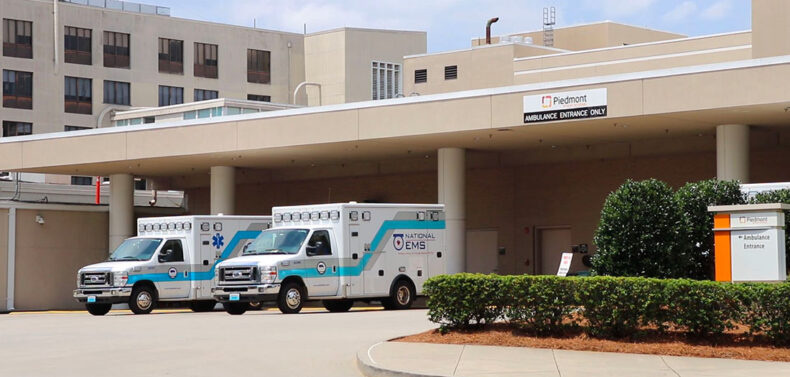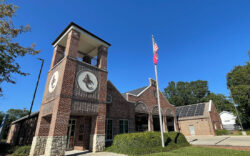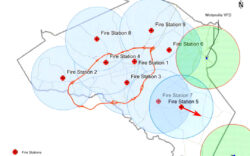The private ambulance company that serves Athens-Clarke and Oconee counties has failed to live up to an agreement made last year between the ACC government and Piedmont Athens Regional Medical Center regarding transparency and response times.
While National EMS has provided some of the requested data, it failed to include important performance metrics in a report to the ACC Commission. Furthermore, some of the data the company did provide showed that their ambulance response times failed to meet the requested standard.
National EMS Vice President of Operations John Bandzul and Battalion Chief Jonathan Pou of the ACC Fire Department gave a joint presentation to the mayor and commission on Apr. 8. In the presentation, they summarized the performance of emergency medical services in Athens in the last quarter of 2024, including data from both agencies.
The ACC Fire Department has nine stations around the county, with 15 total units capable of responding to an emergency, including fire engines, rescue units and other types of vehicles. It handles about 400 emergency medical calls a month, which makes up about half its total call volume.
Throughout the reporting period from October to December, the fire department’s emergency response system was never saturated; it had units available to respond to emergencies at all times. Only twice did it have as many as 11 units busy on calls at the same time, leaving four additional units capable of responding.
The fire department responded to 90% of emergencies within eight minutes and 27 seconds after the initial 911 call, with an average response time of five minutes and eight seconds. This is well within the standards set by the National Fire Protection Association, which require a response to 90% of emergency calls in under nine minutes.
National EMS handles far more calls in a month than the ACC Fire Department, in part because it is responsible for both Athens-Clarke and Oconee counties. It receives about 2,000 calls a month across the two counties, but has only 11 vehicles with which to respond, scattered across only four stations. An additional five vehicles are primarily used for non-emergent, inter-hospital transport but can sometimes be used in an emergency as well.
The increased workload that National EMS shoulders, combined with fewer vehicles launching from fewer stations, inevitably leads to slower average response times and system saturation. All 11 regular National EMS emergency units were committed on calls 18 times in the last quarter of 2024. Twelve times during this period, a 911 call came in, but National EMS had no available units with which to respond. That’s about once a week, on average. In those situations, National EMS can call for emergency support from another county, but this could potentially lead to long wait times for some Athens and Oconee residents who call 911.
National EMS gets many important and time-sensitive emergency calls, but not all of the calls it receives involve a life-threatening emergency. Therefore, National EMS prioritizes 911 calls into two groups, with different response time goals for each.
The average response time for all 911 calls in the last quarter of 2024 was 11 minutes and 29 seconds. The company’s goal is a total response average under 12 minutes, even though this target is listed nowhere in the memorandum of understanding the ACC government signed last year with Piedmont-Athens Regional.
When it comes to the highest priority, most important emergency calls, National EMS responded in eight minutes and 46 seconds on average during the reporting period. That’s more than three and a half minutes slower than the ACC Fire Department. Bandzul told commissioners that this was “right where we want to be.”
National EMS failed to provide its 90th percentile response time to commissioners as required in the memorandum of understanding. That may be because it would show that its response times are in fact far slower than the commission asked for. The memorandum of understanding calls for 90% of National EMS’s emergency responses to come in under nine minutes, as listed in the National Fire Protection Association’s standards.
With an average of over 11 minutes on all calls, that’s clearly not happening. For the 911 calls that National EMS feels are important, an average response of over eight minutes means it’s mathematically implausible that 90% of them could come in under nine minutes.
Commissioner Carol Myers asked some probing questions of Bandzul during the presentation. She asked him to send the commission the 90th percentile response time data and the raw data for the number of ambulances they have operating in Athens on a daily basis. Bandzul replied that he had the 90th percentile response time data and that he would provide it to her that same day. However, he still had not provided that information over a week later, according to Myers.
Bandzul was hesitant to provide the raw data on the number of ambulances operating in Athens, citing patient privacy concerns. Even so, Myers told Flagpole that she hopes to see these numbers soon. “I look forward to seeing the exact numbers, as well as the raw data requested, in order to firm up my confidence in National EMS,” Myers said.
Many insurance providers in Athens don’t cover ambulance rides, which can cause unhappy surprise bills for many patients. The cost of an ambulance ride was Mayor Kelly Girtz’s major focus as he questioned Bandzul. Girtz mentioned that the ACC government is currently providing $100,000 a year to subsidize National EMS, and hinted that this may not always be the case.
“I certainly would expect that [Nationals’] costs have increased, and I have at least some amount of flexibility in my mind when it comes to what future costs [to the local government] may be as a partner in this operation,” Girtz said, expressing a willingness to increase the local government’s contribution. “But among the prerequisites for me in any partnership is that our own employees are covered… our employees are not covered by this operation right now.”
Commissioner Melissa Link also asked if National EMS would consider accepting insurance from UGA employees, the biggest employer in the region. “I do know people who have turned down [ambulance] service, knowing that they would end up with a $3,500 bill,” Link said.
While National EMS could offer to cover specific groups of employees, it is not an insurance company.
“A lot of it comes down to the insurance company,” Bandzul replied to commissioners. “It is very hard to get any of the insurance companies to actually sit down at the table and negotiate in-network status with us. They‘d rather just hear our billing department buzzing in their ear and pass it off to their subscribers.”
Bandzul said that National EMS is in “great support” of “no surprise” billing laws for ground ambulance companies, which he said that 12 states have already passed. “What [‘no surprise’ laws] do is they force the insurer to actually come to the table; they force the insurer to pay the ambulance service direct, and they set a fair rate,” Bandzul said.
Bandzul said that National EMS is sympathetic to the large expense of the service that his company provides, and that it offers discounts and payment plans for those who have difficulty paying.
Like what you just read? Support Flagpole by making a donation today. Every dollar you give helps fund our ongoing mission to provide Athens with quality, independent journalism.










